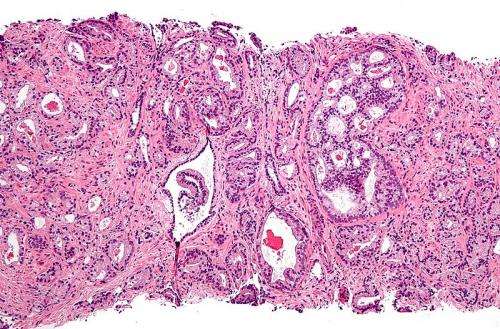Mathematical model predicts patient outcomes to adaptive therapy

Prostate cancer is the most common malignancy among men in the United States. It is also the second most common cause of cancer-related deaths. Despite improved treatments for prostate cancer, many patients with advanced disease eventually develop drug resistance. Researchers in the Center of Excellence for Evolutionary Therapy at Moffitt Cancer Center believe that adaptive treatments based on evolutionary principles may be an effective approach to prostate cancer treatment by preventing the development of drug resistance and prolonging patient survival.
In an article published today in Nature Communications, the research team provides a closer look at a model and data showing that individual patient alterations in the prostate-specific antigen (PSA) biomarker early in treatment can predict outcomes to later treatment cycles of adaptive therapy. These models could eventually be used to devise patient specific treatments according to changing tumor growth and biomarker patterns.
Patients with prostate cancer are commonly treated with radiation therapy or surgery followed by androgen deprivation therapy (ADT) at the highest tolerated dose to kill as many cancer cells as possible. While initial responses to this approach are often effective, eventually patients develop drug resistance and their tumors recur.
"Continuous treatment, by maximally selecting for resistant phenotypes and eliminating other competing populations, may actually accelerate the emergence of resistant populations—a well-studied evolutionary phenomenon termed competitive release," said study author Heiko Enderling, Ph.D., associate member of Moffitt's Department of Integrated Mathematical Oncology.
Enderling and his team, in collaboration with scientists from Duke University, University of North Carolina and Arizona State University, believe that instead of using a continuous maximum tolerated dose, a better approach would be to use adaptive therapy with intermittent dosing. This treatment strategy is based on changing patterns of biomarker levels in individual patients; treatment may increase or decrease or even be temporarily halted according to patient-specific markers and tumor dynamics.
"Fully harnessing the potential of intermittent prostate cancer therapy requires identifying ADT resistance mechanisms, predicting individual responses and determining potentially highly patient-specific, clinically actionable triggers for pausing and resuming intermittent-ADT cycles," said study lead author Renee Brady, Ph.D., a post-doctoral fellow in the Department of Integrated Mathematical Oncology at Moffitt. She added this seemingly daunting challenge could be overcome by advances in mathematical modeling.
Previous mathematical models are based on a variety of different resistance mechanisms and include numerous variables; however, they do not completely predict patient responses and outcomes to intermittent ADT. The Moffitt team built its model on a different theory; they hypothesized that prostate cancer stem cells contribute to tumor differences between patients and treatment failure. They devised a model that simulated and predicted the dynamics of three factors during intermittent ADT: prostate cancer cells, differentiated cancer cells and the biomarker PSA. The researchers validated their model to show that stem cells are highly associated with intermittent ADT resistance. Patients who are resistant are more likely to have stem cells with higher rates of self-renewal, subsequently leading to higher levels of prostate cancer stem cells and changing levels of the biomarker PSA during each treatment cycle.
The researchers combined their model with clinical data from a study of intermittent-ADT therapy and demonstrated that it predicted the development of patient resistance with 89% accuracy. Furthermore, they demonstrated that by using this model, they could predict which patients would benefit from alternative treatments.
These results demonstrate the feasibility of using mathematical models to guide adaptive therapy clinical trials and provide more personalized treatment options to improve patient outcomes. "This ability to learn from early treatment cycles and predict subsequent responses adds an essential degree of personalization and flexibility to a cancer treatment protocol," said Enderling.
More information: Renee Brady-Nicholls et al, Prostate-specific antigen dynamics predict individual responses to intermittent androgen deprivation, Nature Communications (2020). DOI: 10.1038/s41467-020-15424-4

















